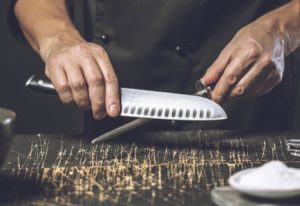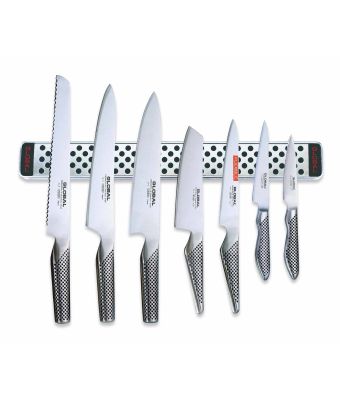When To Replace Kitchen Knives?

If you take good care of your kitchen knives, they will repay the favour. However, there comes a certain point, when sharpening just won't do. While a high quality and professional kitchen knife can have the potential to last a lifetime, the reality is that, in a working chefs environment, your knife will be put to the test and time will make a difference.
Yes, a dull edge can be sharpened, and small imperfections can be removed, but there are certain instances where your knife should simply be retired. So, when exactly is it time to replace your knives?
In this guide:
- The Intro
- Chips
- Rust
- Broken Tip
- Loose Rivets
- Comfort Is Key
- Old Age
- Dull Knife
- Ruining Your Knives
- Throw Away
Chips
The blade on your knife will, without a doubt, get some grooves and small marks – this is all just part of wear and tear in the kitchen. The tiny chips or missing parts in your knives cutting edge are referred to as micro-corrosion. It is often caused by moisture left in the area – this can be any kind of wetness left on the blade from food, so be sure to try and dry your knife after use or washing.
Small imperfections may be able to be smoothed out by a professional, but if a blade gets any large chips in, it may not be fixable and you will have to replace the knife.
Rust
Many stainless steel knives can develop rust, which is usually because of soaking your knives for too long. The stainless element is chromium coated, which if soaked often enough can begin to deteriorate. Once this coating has been compromised, the knife is at further risk of rust development. Extreme heat, excess moisture and salt water can all be causes of rust, as well as improper drying.
A small amount of rust can be removed, but once a knife is rusted in a particular spot, it is incurable. A cut by any rusty blade is not as clean as necessary for food preparation and can add impurities. If you aren’t confident in using the knife due to the amount of rust, it is advised to replace.
Bent/Broken Tip
If you drop your knife, it hits a floor/hard surface tip or you use the front part of the blade to cut something hard, then you can bend or even break the tip. Accidents happen in the kitchen and any chef is bound to experience kitchen nightmares, but even something as simple as cutting into a watermelon can bend or break a tip. This is even more reason to invest in high quality and professional knives.
Your knives manufacturer or a professional repairman may be able to attempt to reshape your blade, but if a considerable amount is missing from the blade, you should consider replacing.
Loose Rivets/Handle
The rivets on your knife are the small metal rounds that secure the tang into the handle. When these come loose, it can alter the stability and balance of your blade, making it less effective and even dangerous. These can be secured by a professional and can often be easy to tighten, but if they are corroded in any way or misshapen, this won’t be possible. Your best fix for this situation is to consider replacing.
There are various reasons why the handle may have broken off from the knife, however, the most likely reason is because of low-quality or old age. The safest option is to replace and invest in a high-quality, strong-structured knife.
Comfort Is Key
Any chef should feel comfortable using their kitchen knives, so if your knife has come to feel too heavy, unbalanced, too large, too small, or does not have the grip you want, it may be best to consider donating it elsewhere and replacing it with one that fits you, your style and comfort preferences. Make sure to do your research beforehand or try before you buy, to find the perfect knife for you.
Old Age
It is often the case that the more you use a specific knife, the more attention and care it will need. When you sharpen your blade you will be inevitably removing small amounts from the surface. After a while, it may seem like your knife requires more frequent sharpening. There are a few things you can do to prolong your knives life, but at some point, the wear and tear of your knife combined with the age may call for new tools. Only you will know when it’s time for a new knife!
Dull Knife – Replace or Sharpen?
A dull knife can be dangerous, time-consuming, difficult to use, and extremely frustrating, whereas a sharp and well-honed knife will glide through your food, making your job much easier.
If your knife’s blade has gone dull or isn’t straight, don’t automatically think you need to throw it out. Almost any blade can be sharpened, but you just need the right tools and the right know-how.
Many professional chefs will treat their blades with a sharpening steel before every use, but believe it or not, these tools are not actually doing the sharpening. They are actually realigning the blade. While the difference between sharpening and honing is only subtle but it can make a much more obvious difference and determine the cut and efficiently of a blade.
When your knife gets dull, the sharp edge will have been lost or the blade’s edge is no longer aligned. The blade may still be sharp, but when you lose even the slightest bit of alignment, you won’t be able to cut through food as efficiently.
Honing – Honing steel pushes the edge of the knife back to the centre and straightens it out. It will correct the edge without shaving off much, if any, of the blade. While honing doesn’t technically sharpen your knife, if it’s done properly, your knife will seem sharper because the blade is in the right position. Honing should be done often, with some chefs even honing before each use.
Honing rods catch the miniature hooks and smooth them back into the original shape. By using honing rods before use, you can keep your knife sharp few numerous months at a time.
Sharpening – In comparison to honing, when you sharpen your knives, you will see ground shards of the blade. This is done to produce a new and sharper edge. This can be done using a water stone, whetstone, or electric knife sharpener. Sharpening can be done much less frequently than honing, in fact, just a few times a year, dependant on how much the knife is used.
Tip: Never use your knife directly after sharpening. The microscopic bits of metal which are produced can get in the food. Be sure to wash it or wipe it down first.
The metal at the end of your knife blade is similar to a pipe cleaner. It is bendable, thin and can easily take new shapes. When you press down on a blade onto a solid surface, the edge will bend – this may only be at a microscopic level, but over time it impacts the use, shape and sharpness.
Ways You May Be Ruining Your Knives
- Your chopping board – Compared to steel, ceramic or stone, plastic and wooden chopping boards are less likely to dull your knives and kinder to the blade. Striking your knife on a hard surface can dull the blade.
- Using the wrong knife for the wrong task – ‘Cutting corners’ and reaching for the nearest knife won’t help the condition of your blade. For example, cutting through joints or bones should be done with a cleaner or boning knife, not a chef’s knife. This can be dangerous, damage the food and your knife.
- Washing or soaking – Soaking your knife is an invitation for rust. Be sure to wash and dry thoroughly and quickly. Avoid washing your knives with other cutlery also. Knives knocking against other items guarantees dull and damaged edges. Avoid leaving your knife out to dry on a draining board – this runs the risk of rust and being knocked against other utensils.
- Dishwashers – High heat and humidity is not a good combination for the care of your kitchen knives. Knives with wooden handles are particularly vulnerable in dishwashers as it can force the handles loose over time.
- Storage – The storage of your knives is vital. Storing sharp knives in a drawer can mean blades knock and damage is caused. A magnetic knife rack or knife block is better.
- Honing – Not honing regularly enough means your blade will quickly become dull. Honing with a diamond honer smooths out any nicks and helps repair the metal.
- Over sharpening – Sharpening too much could mean your blade wears down sooner and can cause the edge to wear down into the thicker part of the blade, meaning the knife edge will become thicker and duller.
Throwing Away A Kitchen Knife
High-quality kitchen knives are a true investment if you are a professional in the industry, but when it comes to throwing any away, you can’t simply add it to the food waste bin. When your knife has run its course, it is extremely dangerous to just throw it in the bin, even if it is wrapped up well. Even dull blades can cause cuts, so, what do you do?
1. Charity/Goodwill – Even if, by your standards, the knife is not usable, it may help someone else out. Be sure to safely wrap the knife and that before sending it to a new home, make sure it is clean and safe.
2. Recycling – Make sure to check with your local recycling companies. They will usually have a facility for kitchen items such as knives. Make sure they are wrapped appropriately before recycling.
3. Throwing out – If you are intent on throwing the knife out, be sure to cover substantially. Wrapping in cardboard and bubble wrap can help, but also placing it in a cardboard box will decrease chance of risk and injury.
4. Contact a local knife-sharpener – You may no longer have a use for your knife, but a professional knife sharpener might. They may be interested in purchasing an old knife for repurposing and repairs.
5. Scrap metal – If you know what type of metal your knife is, (most are steel, iron or a mixture) then you may be able to sell it for scrap.
Tip: Stainless steel knives would benefit from honing with a steel every 2-4 uses. Carbon steel knives should be honest after every use. If you have been honing regularly, you should not need to sharpen as much. Note that this will depend on the condition of the knife.

